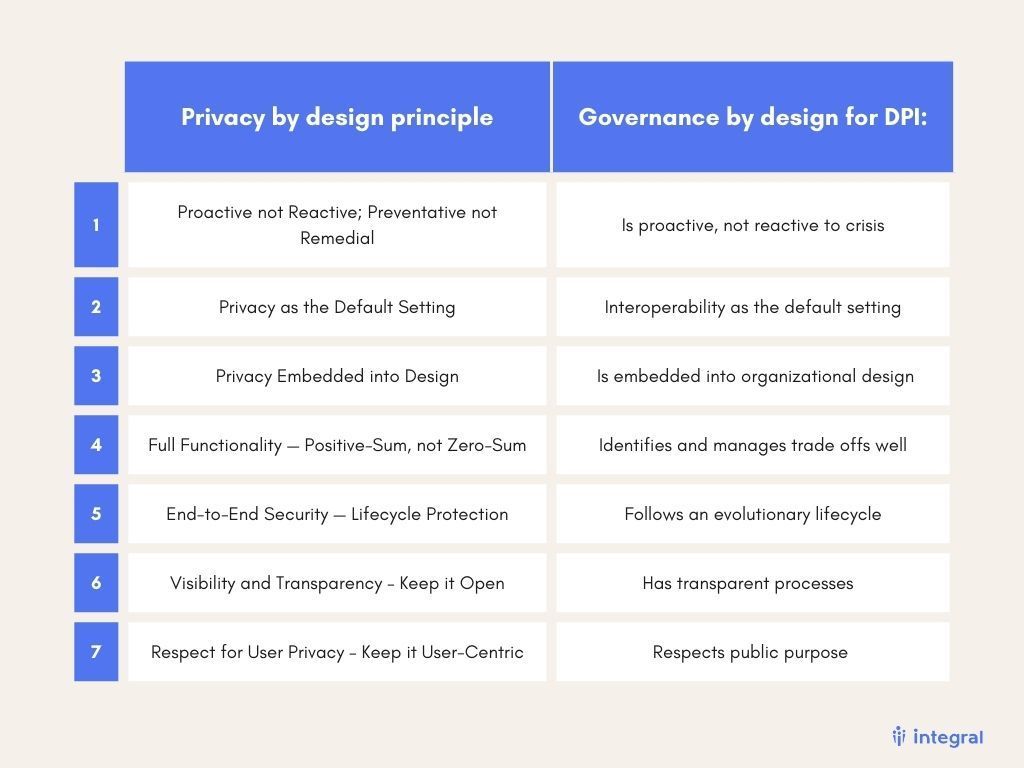555-555-5555
mymail@mailservice.com
Connecting Frameworks: Privacy by Design and Governance by Design for DPI
Stay up-to-date on trends shaping the future of governance.
There is general agreement that good governance matters for Digital Public Infrastructure (DPI). There is much less agreement at this stage about what governance means in a DPI context. One way to explore building consensus is to explore whether existing widely accepted frameworks could be adapted to the DPI context.
Since DPI at its heart is all about exchanging digital data for different purposes–from payment to identification–it seems appropriate to consider the original ‘by design’ framework which was developed for data privacy. This framework was built around the concept of Privacy by design.
Since its first use in 1995, privacy commissioners and data protection authorities around the world have recognized privacy by design as an international standard which they intended to promote and incorporate in policy and law. It was originally articulated as seven principles which together signaled an intention to embed privacy considerations proactively throughout the data use cycle.
While the privacy by design framework is agnostic about the organization handling the data, the operators of DPIs are types of institutions with a particular purpose which demands specific governance features. The comparison of data to DPI is somewhat akin to that between blood and the heart in the human body–blood, like data, is widely distributed but the heart is the ‘essential infrastructure’ responsible for pumping it. Privacy by design is about protecting the ‘blood chemistry’; governance by design for DPIs is about ensuring that the ‘heart’ functions well, including but not only protecting the unique blood chemistry. So, governance is really the means which connects to ends like this.
With that contrast in mind, how well might the principles of privacy by design inform governance by design?
The table below maps privacy by design principles in the first column to my suggestions of counterpart principles for governance of DPI in the second column. You will see that the majority of principles (those numbered 1,3,5 and 6) map across pretty easily to governance of DPI. This isn’t surprising, considering a concern for ways of using data is at the heart of both.

However, some principles need adjustment for the DPI context. For example, #2 (privacy as default) probably needs more emphasis on interoperability by default for DPI; and #4 (privacy is not zero-sum) recognizes that the job of governance is in fact to identify and manage trade-offs of various types (although not necessarily with user privacy).
Finally, principle #7 (respect for user privacy) could be carried across to DPI but I think the respect in question for DPI is something broader: I would propose that it is respect for the public purpose for which a DPI is provided. This means that, whether or not DPI is formally regulated, it needs to be accountable for the achievement of a recognized public purpose. If accountability for purpose cannot be achieved through regulatory oversight for some reason, then this principle suggests that individual DPIs would nonetheless respect the need to articulate clear purpose, to report against it and to have mechanisms to keep them ‘on purpose’.
At Integral, we provide ESG Consulting advice, evaluation, facilitation, mentoring and coaching services to develop governance systems that fit your organization’s purpose and stage of growth. To explore further how we can help you,
read about our services, or
set up a free consultation.










Integral is a service of Digital Frontier Services Inc.
a MA registered corporation. Privacy Policy
© 2021 Digital Frontier Services Inc. | All Rights Reserved
